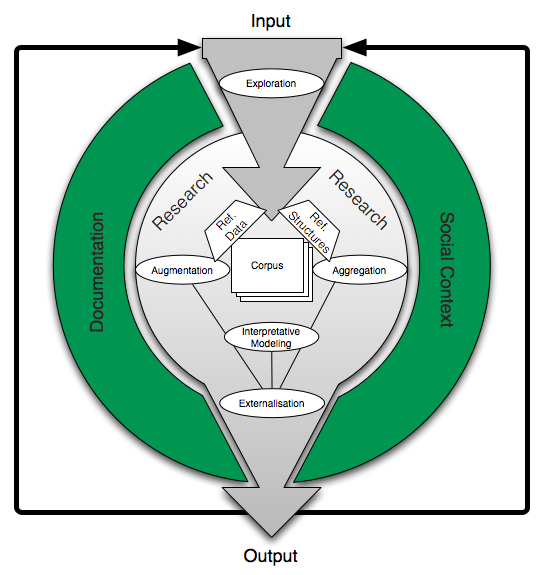1 Introduction
The aim of DM2E’s Task 3.4 was to investigate how a digital humanist uses digital research tools and how his actions can be modeled. With respect to the environment of Linked Data and Europeana, the initial question were “What does the humanist want to do with the digital tools?” and “What are the ‘functional primitives’ of the digital humanities.”
With our model, the Scholarly Domain Model (SDM), we try to initiate and encourage more reflection on the methods of humanities scholars in a digital environment, and, at the same time, to connect the development of applications closer to scholarly practices.
2 Scholarly Domain Model
The model groups together the activities of a generic research process and constitutes the primitives of scholarly work. The model itself consists of different layers of abstraction, each one describing the field with more granularity. The top layer displays Research as the central aspect of the SDM, but it makes it clear that is dependent on input and will ideally produce output. The arrows leading back to input indicate that the output of one iteration can be used as input to a following research process.

Additionally, Research is embedded in a social context, which includes collaborative aspects and a documentary context, like reporting to a funding organization or blogging about a project.
Each layer zooms more in on the different activities that can be part of the scholarly domain. The lowest level, Scholarly Operations, being designed to be domain-specific implementations of the upper levels: all scholars use references, but how is a reference specifically done e.g. in linguistics?
We see the SDM as a living model and a framework for discussions on the humanities and the digital domain.
3 Application Scenarios
We hope that with the implementation of the SDM as an RDFS/OWL ontology we can build a bridge between the model and applications recurring to this model. Also, the model will help to identify gaps in the scholarly workflow and design tools that fill these gaps. Thirdly, aspects of scholarly work that are not yet covered by tools can be integrated. By providing this model we aim to contribute a significant building block to the digital humanities and try to enhance the sustainability of infrastructures.
A full report on the Scholarly Domain Model and the work conducted in Task 3.4 will be published at the end of DM2E in January 2015.
Steffen Hennicke, Humbolt-Universität zu Berlin

Comments are closed.